

Krzysztof Kaczmarczyk
Technology Manager at ATT.
Robotization and automation of production processes have been constantly introduced for last decades. These processes are being adopted in constantly widening spectrum of production phases. The aim of robotization and automation is to increase production efficiency, improve products quality, and repeatability. It is forecasted that in the near future every production industry will use a robotic station.
The International Federation of Robotics (IFR) has published its latest report on new robot installations in factories around the world. 553 052 robots have been installed in 2023, which means 5% increase compared to corresponding period of 2022. When selecting the data per continents, Asia is leading – 73%; Europe 15%; American continent 10%; others 2%.
Introduction of robotic stations in the production is the subject of deep economic analyses and it seems to be justified only in large-scale production. The most important parameter defining the feasibility of robotization is ROI (Return of Investment), which takes into consideration economy, time effectiveness, precision, repeatability. It is worth to mention that part of these factors may and do significantly influence on hygiene features of goods.
In case of companies providing solutions for F&B industry, the automatized processes of production are being often introduced in operations related to welding and grinding – key for hygiene performance of products.
In the first place, ATT has automized the process of point drainage production. We identified this stage as crucial to obtaining the product with high level of hygiene. the justification for the above decision was importance of the drainage process in food processing plants. The system creates a buffer between the “clean” and “dirty” zones. Installation of drainage products with low hygienic standard may result in harmful substances (being present in the sewage system) penetrating to the clean/high care zone and contaminating the production area.
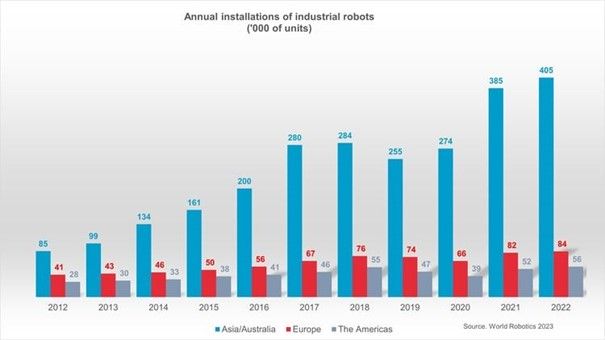
Due to the design of the point drain construction made of high-quality deep-pressed elements, we succeeded to minimize the number of welded joints on the entire drain body to only two. Welded joints are made automatically in accordance with WPQR and WPS technology, that guarantees restrictive quality and hygiene parameters. Thanks to such design of the drain body, we effectively minimize places where dirt accumulates, and as a result we reduce potential development of dangerous bacteria.
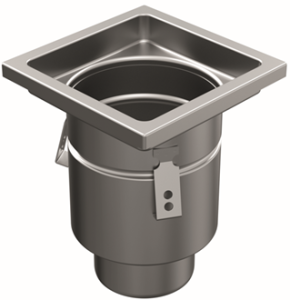
Pic. Hygienic deep pressed floor drain top, without sharp corners, enables self-cleaning and blocks bacteria growth.
As it was mentioned, the key criterion of the profitability of process automation and robotization is increasing efficiency and simultaneously errors reduction – resulting in quality improvement. We compared the production data of one of our floor drains – W200/110V1 that was manually and automatically manufactured in our plant. We managed to increase production efficiency by 35% and eliminate welding errors by 0.5% (testing sample of 1000 pieces).

To complete the production process of hygienic point drainage, we introduced welding automation of ladder grates. The grate located in the upper part of the drain also should be designed and manufactured the way that places where dirt accumulates are significantly limited. As a result the habitats of dangerous bacteria are minimalized. Very important parameter of the drain grate is its resistance to load. Automatic welding guarantees a process of high precision and durability – these are crucial parameters for the hygiene of the grate structure and its usage. Automatic TIG welding provides repeatable welding joint geometry that does not require further mechanical processing.
Next to the drainage system, we could also elaborate automation of food processing equipment production. An example of such a product is a stuffing bin. The product requires relatively high precision. The parameters of the bin in volumes of 120 liters, 200 liters and 300 liters are specified in the DIN 9797 standard. Geometric dimensions are very important to ensure that the product is compatible with automatic loading systems used in food factories. Another key parameter of the bin is tare weight, which following the capacity is equal to: 120 l – 30 kg ± 250 grams; 200 l – 40 kg ± 250 grams and 300 l – 50 kg ± 250 grams. The bin is usually used to transport food products or food ingredients. Due to that fact, internal surface must be smooth with low roughness parameter. The above requirements and large production volumes clearly define the guidelines for automation process implementation.
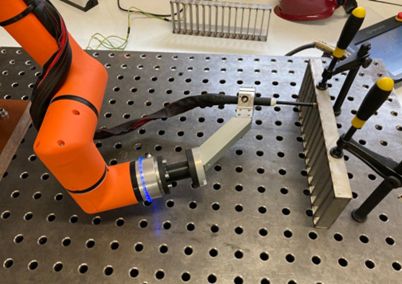
The first step included the implementation of a robotic welding cell for two welding methods: TIG and MIG/MAG. The bin is welded from deep-pressed components. While welding process, the elements are positioned and fixed by specially designed tools. Stable position of welded parts in combination with technological precision guaranteed by robotic welding provides precise, stable, and repeatable manufacturing.
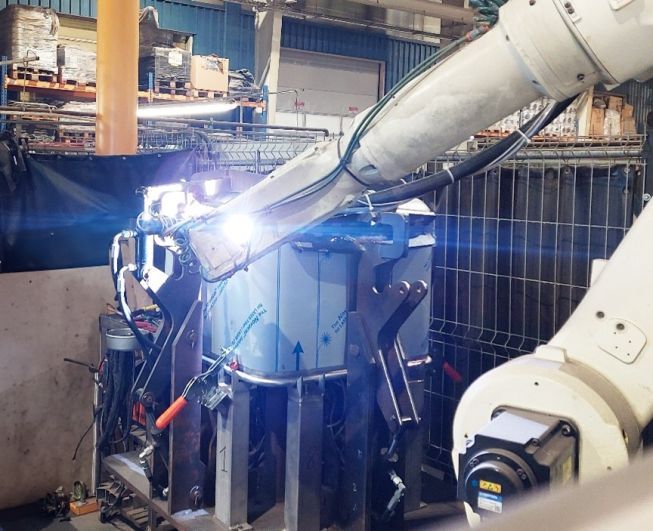
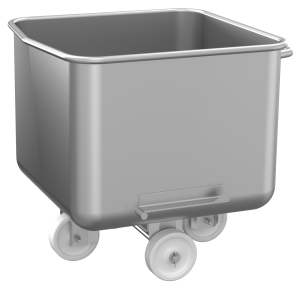
In the first period of production, the process of grinding welds in the stuffing bin was carried out manually by production staff. The analysis of the high consumption of abrasive materials in the manual process proved low repeatability, high cost and low time efficiency of manufacturing. Aa a result, it was decided to build dedicated robotic grinding cell. Intelligent, automized use of grinding parameters by the robot in line with development of abrasive materials parameters improved quality, effectiveness and time consumption of processes. The robotization of the process reduced the costs of purchasing of abrasive materials for the stuffing bin grinding process by 54%. We also noticed significant increase of surface quality after the process is completed.
Automation and robotization with appropriate ROI calculation is huge value added in the production process. In the case of companies producing structures and stainless steel elements dedicated to the food industry, the implementation of robotic stations works well in large-scale processes where precise and repeatable welding and grinding operations are required. Thanks to the use of automatic and robotic solutions, we are able to significantly reduce number of errors which enable us to keep high hygienic values.


 Następny
Następny
